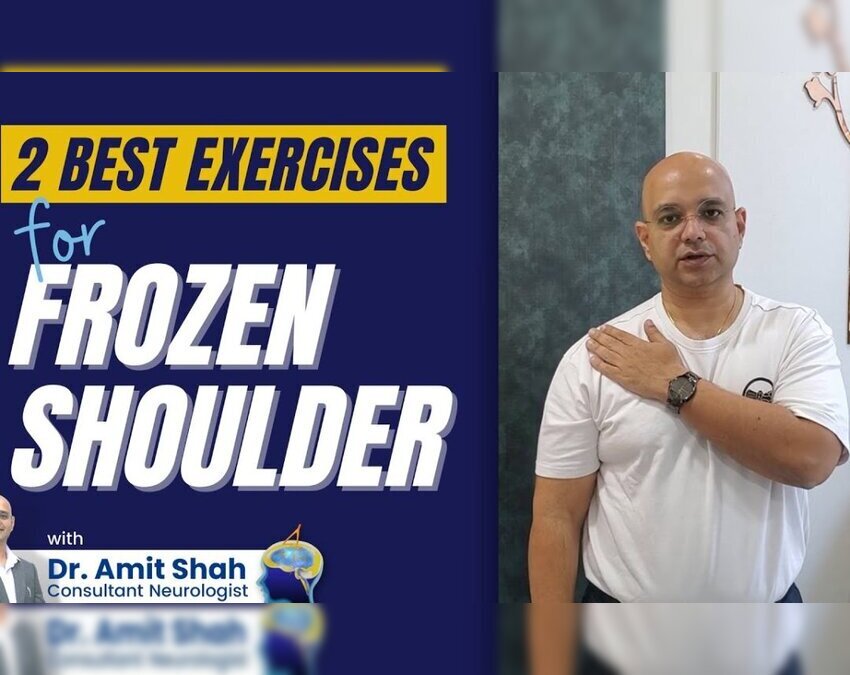
Frozen shoulder, also known as adhesive capsulitis, is a painful condition that restricts shoulder movement. Dr. Amit Shah, a renowned neurologist, recommends a series of specific exercises to improve mobility and alleviate discomfort. These exercises target the stiff shoulder joint, helping to reduce pain and increase flexibility over time. In this guide, we will explore the best exercises for frozen shoulder that can be done at home or under the supervision of a healthcare professional.
Understanding Frozen Shoulder
Frozen shoulder occurs when the connective tissue around the shoulder joint thickens and tightens, restricting movement. The condition often develops slowly and can last for months or even years. People with diabetes, those who have had shoulder surgery, or those with prolonged immobility are more prone to developing frozen shoulder.
The Importance of Exercise for Frozen Shoulder
While frozen shoulder can be painful, regular movement is essential to prevent further stiffness and improve shoulder function. The best exercises for frozen shoulder focus on stretching and strengthening the muscles around the shoulder joint, allowing for a gradual increase in range of motion.
Warm-Up Before Exercises
Before starting any exercise routine, it’s important to warm up your shoulder. A gentle warm-up increases blood flow to the area and helps prepare your muscles for movement. You can use a heating pad for 10-15 minutes, or take a warm shower to loosen the muscles. This step is crucial for preventing further injury.
Best Exercises for Frozen Shoulder
1. Pendulum Stretch
- How to do it:
- Stand beside a table and lean forward slightly, supporting yourself with the unaffected arm.
- Let the affected arm dangle freely and begin to move it in small circles (about 10 times in each direction).
- As your range of motion increases, make the circles larger, but keep them gentle.
- Benefits: This exercise helps to mobilize the shoulder joint gently without putting too much strain on it.
2. Towel Stretch
- How to do it:
- Hold a towel behind your back with both hands, one hand holding it at the top and the other at the bottom.
- Slowly pull the towel upward with the good arm to stretch the affected shoulder.
- Benefits: The towel stretch improves flexibility and mobility in the shoulder, targeting the tight joint capsules.
3. Cross-Body Reach
- How to do it:
- Sit or stand with your back straight.
- Use your unaffected arm to lift the affected arm across your body at shoulder height.
- Hold the stretch for 10-15 seconds, then release.
- Benefits: This stretch enhances the range of motion by loosening tight shoulder muscles and tendons.
4. Finger Walk
- How to do it:
- Stand facing a wall at an arm’s length distance.
- Slowly walk your fingers up the wall as high as you can without causing pain.
- Once at the top, gently lower your arm and repeat the process.
- Benefits: The finger walk exercise increases shoulder mobility in a controlled and gentle manner.
5. External Rotation
- How to do it:
- Sit next to a doorframe or in a doorway.
- Bend your elbow to a 90-degree angle, with your forearm parallel to the floor.
- Hold a resistance band attached to the doorframe with the hand of your affected arm, and gently pull it away from your body, rotating your shoulder externally.
- Benefits: External rotation exercises strengthen the muscles around the shoulder joint, aiding in recovery and reducing stiffness.
How Often Should You Perform These Exercises?
Dr. Amit Shah recommends doing these best exercises for frozen shoulder once or twice daily. Consistency is key in reducing shoulder stiffness and improving mobility. However, if you experience sharp pain or increased discomfort, it’s important to stop the exercises and consult with your doctor.
Conclusion
Recovering from frozen shoulder can take time, but with consistent effort and the right exercises, you can regain mobility and reduce pain. The best exercises for frozen shoulder, as outlined by Dr. Amit Shah, focus on gentle stretching and strengthening of the shoulder joint. By following this routine, you can enhance your range of motion and speed up recovery. Always consult a healthcare professional before starting any exercise regimen, especially if you have underlying health conditions.
For a personalized recovery plan and to start your journey towards a pain-free shoulder, try the Best Exercises for Frozen Shoulder recommended by Dr. Amit Shah. If you’re struggling with frozen shoulder and need expert guidance.
Book an Appointment: Tap hereLocation: Click HerePhone: 98195 61456, 93213 66625
Email: info@dramitshahneuro.com
Follow us on Social Media for updates: Facebook | Instagram | YouTube
Take the first step toward regaining your mobility today!







